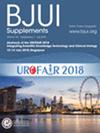Patient‐reported outcome measures in prostate research: a scoping review
IF 4.4
2区 医学
Q1 UROLOGY & NEPHROLOGY
引用次数: 0
Abstract
ObjectivesTo summarise how patient‐reported outcome measures (PROMs) are used in prostate research, specifically in the 10 years after the 2010 CONsolidated Standards Of Reporting Trials (CONSORT) guidelines were introduced.MethodsThe search was focussed on randomised controlled trials (RCTs) reporting in the top 15 journals in oncology, urology, and medicine, during 2011–2020 and identified through PubMed®. For each article the following items were identified: the condition being treated, the intervention(s) of interest, the study design, the specific PROM(s) used, when they were included in the treatment pathway, how they were analysed, and whether methods to deal with multiplicity or missing data were considered.ResultsThere were 361 potentially eligible articles identified from the PubMed search, of which 121 were eligible for the full‐text review. The articles were RCTs assessing interventions for lower urinary tract symptoms (前列腺研究中患者报告的结果测量:一项范围综述
目的总结患者报告结果测量(PROMs)在前列腺研究中的应用情况,特别是在2010年合并试验报告标准(CONSORT)指南引入后的10年。方法检索2011-2020年期间发表在肿瘤学、泌尿学和医学领域排名前15位期刊上的随机对照试验(rct),并通过PubMed®检索。对于每篇文章,确定了以下项目:正在治疗的病症,感兴趣的干预措施,研究设计,使用的特定PROM,何时纳入治疗途径,如何分析它们,以及是否考虑了处理多重或缺失数据的方法。结果从PubMed检索中确定了361篇潜在符合条件的文章,其中121篇符合全文综述的条件。这些文章是评估下尿路症状(n = 54)或前列腺癌(n = 67)干预措施的随机对照试验,其中最常报道的PROMs分别是国际前列腺症状评分(50/54)和癌症/慢性疾病治疗功能评估问卷(28/67)。分析和处理PROMs的细节难以获得;值得注意的是,60%的文章没有提及是否使用了任何方法来处理多重性或缺失数据。一个偶然的发现是,在一些文章的分析中,性行为不活跃的男性被排除在外。结论我们的范围综述强调需要改进前列腺随机试验中PROMs的纳入和分析方式,以便他们的发现可以有效地应用于进一步的研究和临床实践。应鼓励遵守CONSORT指导方针,特别是明确报告prom的时间、丢失数据的处理和多样性。前列腺癌的随机对照试验将受益于核心结局和测量集,以避免不必要的重叠并促进证据合成。
本文章由计算机程序翻译,如有差异,请以英文原文为准。
求助全文
约1分钟内获得全文
求助全文
来源期刊

BJU International
医学-泌尿学与肾脏学
CiteScore
9.10
自引率
4.40%
发文量
262
审稿时长
1 months
期刊介绍:
BJUI is one of the most highly respected medical journals in the world, with a truly international range of published papers and appeal. Every issue gives invaluable practical information in the form of original articles, reviews, comments, surgical education articles, and translational science articles in the field of urology. BJUI employs topical sections, and is in full colour, making it easier to browse or search for something specific.
 求助内容:
求助内容: 应助结果提醒方式:
应助结果提醒方式:


